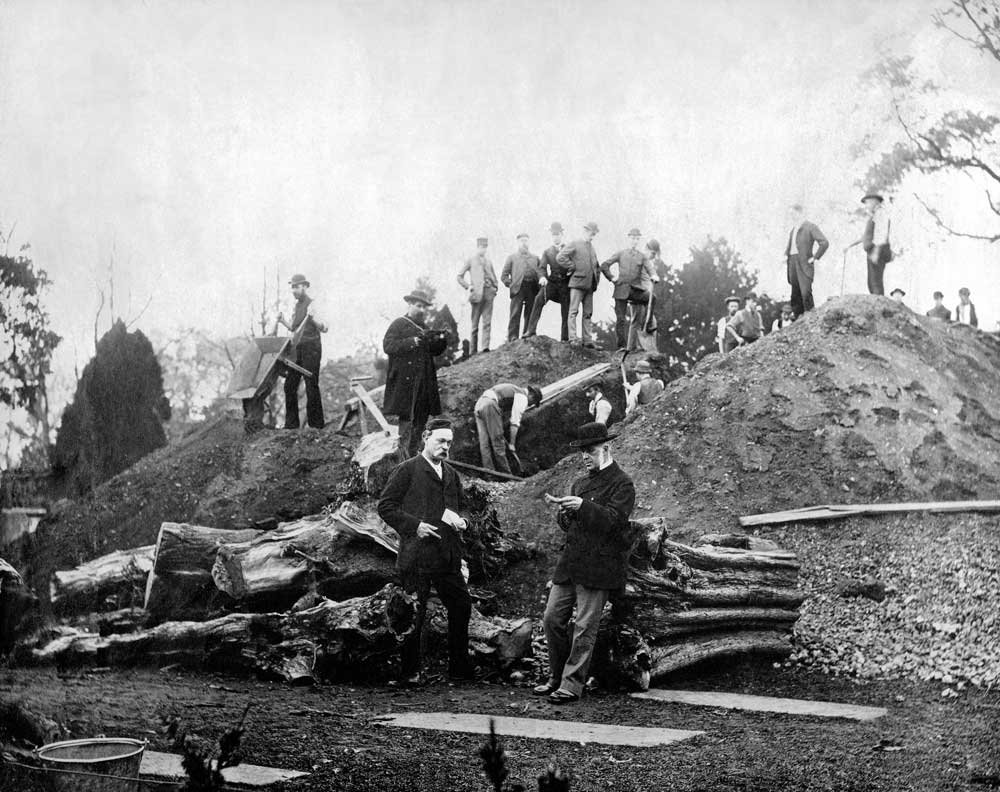The Hills Have Eyes | History Today - 4 minutes read

You can’t plan a journey in the past, or so the train app told me. That was its polite way of informing me that (as happens pretty often) I’d accidentally put in yesterday’s date when trying to check the time of a train. Regarding trains, I’m prepared to accept that the app has a point. But of course you can plan a journey in the past, and on this particular day that wasn’t a bad description of what I was trying to do.
I wasn’t planning a journey very far – 20 miles and 1,400 years back in time. My destination was the village of Taplow, beside the Thames on the southernmost edge of Buckinghamshire. To medievalists it is significant as the location of an important Anglo-Saxon ‘princely burial’ which gave its name to the village itself, since Tæppas hlæw means ‘the barrow-mound of Tæppa’. We don’t know who Tæppa was, but his mound yielded extraordinary riches. Excavated in 1883, it was at that time – while the treasures of Sutton Hoo still lay hidden in the earth – the most splendid Anglo-Saxon burial ever found. The man in the mound had been buried in a wooden chamber and equipped with a magnificent collection of grave-goods, beautifully crafted and evocative of Anglo-Saxon aristocratic life. He had spears and shields, but also drinking horns and glass beakers, game pieces and a lyre – everything a warrior might need for a feast.
If all this was meant to accompany Tæppa into the afterlife, he has had to do without it, because the objects are now in the British Museum. So why go to Taplow? Planning a journey to visit any Anglo-Saxon site is a bit of a gamble, because you never really know if there will be much to see; in most cases little survives above ground, after centuries of building and rebuilding. But still nothing can substitute for seeing the place itself, so I found myself in Taplow.
It’s a special place. The barrow, restored after excavation, stands grass-covered on the slope of a steep hill above the river. Looking out from the mound, on the horizon I could see far westwards over the Thames, to where the downlands of Wessex met wintry skies. When Tæppa was buried here in the early seventh century, it was probably border-country – perhaps, it’s thought, the very edge of a region under the power of the kings of Kent. Was this warrior buried here so that he could keep watch over the border, gazing boldly out into enemy territory? We know that Anglo-Saxon barrows were meant to be highly visible and sometimes imagined as having a protective function, as if the warrior buried inside retained a posthumous sway over the landscape dominated by his mound. His memorial was meant to be seen, but also perhaps to see, to watch over the river and the Wessex hills.
That’s not all that makes this place special, because there are many layers of history here. Long before the barrow-mound was raised, this was already the site of an Iron Age hill fort. Long afterwards, a grand house was built just yards away: Taplow Court, a Victorian imitation of an Elizabethan red-brick manor. The barrow is also in the graveyard of a now-vanished medieval church, demolished in the 19th century. Tæppa’s people would have been among the last generations of pagan Anglo-Saxons in this region; when Christianity arrived, they built their church on the hillside spot already hallowed by a powerful ancestral presence. Perhaps they were somehow absorbing their late chieftain, their guardian spirit, into the new faith.
Many later generations did the same. Though the church is gone, the graves of the churchyard remain, so Tæppa’s mound is surrounded by much later memorials. There, the slanting afternoon light falls on elaborate 19th-century tomb chests and gravestones carved with skulls. All through the centuries as those people were being buried there, the warrior was lying in his mound with his weapons and drinking-horns around him. How long did they go on thinking of him as a presence in that mound, watching over them?
It was strange to enter that churchyard and be transported in imagination from the tame commuter belt of southern England into a wild border-country guarded by a prince’s ghost. To plan a journey in the past here could never mean just being carried back to one moment in history, but travelling through many accumulated layers of time, receding away into the distance like the shimmering haze on the Wessex hills.
Eleanor Parker is Lecturer in Medieval English Literature at Brasenose College, Oxford and the author of Conquered: The Last Children of Anglo-Saxon England (Bloomsbury, 2022).
Source: History Today Feed